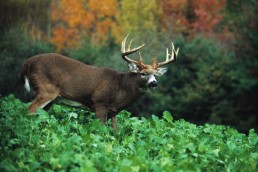Small Parcel Hunting Land Management for Trophy Bucks
SHARE THIS POST
The dilemma next door, trophy buck lands
With a property of less than 40 acres, can you influence whitetail movements or make hunting better? I receive many communications from beginner whitetail managers who have small parcel properties, some 20 acres and less. Is it worthwhile to manage these small tracts? Can you influence buck size, herd dynamics and hunting opportunities? Absolutely! Here’s how.
With a much larger parcel, it is easier to control many aspects of your management efforts and better influence others—especially the “harvest” part of the management equation. Even if you don’t practice other management routines, “selective harvest” has a huge influence. Killing the right deer and removing the correct amount of animals are both essential for many reasons.
There’s also a way to search for and “acquire” one of those “special places.” Places like the spots that are safe havens that traditionally hold mature bucks. Or, maybe a special funnel that deer use annually. You can find a property right next to someone who has been practicing quality deer management for years. Or, maybe you want a place with a distinctive feature like a natural mineral site or dependable water source. All are now easier to locate because of companies like Mossy Oak Properties. These land specialists are hunters and land managers who understand what to look for. You may have heard someone describe a spot as “only 20 acres, but the ‘right’ 20 acres.” Land specialists at companies like these specifically search for properties with great hunting spots, including small parcels.
Promoting the herd
Whitetails jump fences and we have no control over our fellow citizens. So, if you don’t work with your neighbors, herd management can become a wearisome, unachievable task. However, you should always strive to achieve a balance in the local herd.
The premise of most herd management scenarios is simple: Let small bucks live to maturity, 5 years old, and harvest an acceptable number of female deer to keep the density at healthy, stress-free levels. But, if your neighbors kill the small bucks and don’t harvest does, things become frustrating.
Here’s one I’ve heard before: “I shot the buck because he was going to jump the fence. If he hops the fence, my neighbor will just shoot him anyhow.” I promise you, if you rationalize that you must kill a small buck before your neighbor does, you will never make hunting any better for anyone. You must set your goals, stick to them and not worry about what your neighbors do.
Create a plan and lead by experience on your small parcel! This is how big buck hot spots come to be. Look at what the Drurys or Dr. Grant Woods have done in Missouri, or what the Lakoskys and Kiskys have done in Iowa. I know they own farms larger than we’re talking about, but even with a small parcel, if you stick to this aspiration, you will likely see noticeable results in only a couple years!
Let results speak for themselves
In most cases, if your neighbor is a hunter and not simply stupid, by watching you, they will realize that a sound management philosophy pays huge dividends. Talk to your neighbors and lead by example!
By employing sound management philosophies on your small parcel, you can have a titanic influence over your whitetail herd and your hunting. Whitetails are homebodies. What you do “here” influences every animal whose home range encompasses “here.”
After spending their first year with their mother, an adult whitetail chooses a spot to reside and hardly ever roams far from it.
Don’t forget to walk your property, after the season, looking for shed antlers.
Big bucks on the move
Males most often take up a home range a fair distance from where they were born. Their journey to find an adult home range may be only a mile or two. Or, it might be 60 miles away from where they were born. This depends upon many factors, including the type of terrain and habitat, deer densities, age structure, and buck to doe ratios.
Females typically establish an adult home range near to and usually intertwined with their mothers. This is why doe harvest is so important. A given piece of land will hold X amount of deer. If you remove one doe, there’s a 50 percent chance another doe will fill the space. So, you need to remove more does than you may think for the chance that a buck might move in and fill that spot.
Are you enjoying this post?
You can be among the first to get the latest info on where to go, what to use and how to use it!
Bucks may wander for a longer period before they find a spot to spend the rest of their lives. Typically, this happens when the buck is 12 to 18 months old, but it can take longer. If they have their basic needs met and aren’t molested, they likely will reside on the same home range the rest of their lives. Core areas within their home range change seasonally to meet their needs, but to a whitetail it’s “home sweet home,” and they’re there to stay.
Helping out your homebodies with small parcel hunting land management
Since whitetails live in a defined home range, if your property is in it, you can affect the deer’s health, growth possibilities and how often it frequents your small parcel.
Basic management strategy is to let bucks live to maturity and harvest enough does so that the territorial tendencies of whitetails don’t keep other bucks from taking up residence in your area. Let’s put the two concerns in layman’s terms: “Dead deer don’t grow,” and “If all of the rooms are full, he’s got to live somewhere else.” Smart harvest decisions are vital to small parcel success.
Most serious hunters know about the “Food, Water, Cover, Sanctuary” formula. All parts of this recipe are important. Which should you start with? It depends on what you already have. What are your property’s strong suits and what do your neighbors have to offer?
With small parcels, it can be difficult if not impossible to provide all the elements that produce trophy bucks. Since you know that whitetails use your property for at least a portion of their needs, you must consider the entire surrounding area. Learn your property’s strengths and weaknesses. You must do the best with what you have and the herd also will have to use some of your neighbors’ resources. Manage your property to mesh with the surrounding area.
Crossing property lines
On larger properties, you don’t want your herd to hop the fence for anything. But, with small acreage you need to bet that they definitely will cross your border. You must have some part of the formula on your side of the fence so they come back, but be imaginative and let your herd use your neighbor’s resources to your benefit.
Managers of small properties lack the space to host many whitetails. Biological and social carrying capacities mean you just can’t fit that many animals into a small area. You’ll either stress them or they will degrade the habitat.
Densities vary widely throughout the Midwest—anywhere from 5 or 6, up to more than 50 animals per square mile. As an example, let’s use the generous estimate of 30 deer per square mile. That means, with 640 acres in a square mile, and 30 deer in that square mile, your 20 acres likely will hold one whitetail. If you do things right, you can hold more. But, you can see my point. Are you better off devoting ground to bedding or to feeding?
No two spots the same
It’s also a fact that all small properties are not created equal. Because of certain characteristics, or combination of characteristics, there’s no doubt that particular small parcels are much more appealing to whitetails than surrounding acreage—a property that holds something uniquely appealing that whitetails love, crave, have to have, or have to use. Recognize these unique features and get the most out of them.
More than likely, on small parcels, the one part of the formula that’s easiest for a property owner to deal with is the food. It’s also where you will likely see the biggest impact. Attraction during hunting season is the food plot goal of most. But, on small parcels, you probably don’t have enough acreage to attract deer all season long. You may have to be very selective about what you plant. You want your food plot crop to reach its peak attraction when you want to hunt the site.
With small parcels, your neighbors can be a key to how good your hunting will be. People working together can accomplish so much more than those who butt heads. Whitetail management cooperatives are becoming more and more popular. If you get five to ten property owners with 20- to 40-acre parcels, you can have your own whitetail Mecca if everyone does things right. Even with larger properties, the best option is to always work with your neighbors rather than compete against them. It is amazing what a group of like-minded land managers can do.
If you enjoyed this article, check out this article on hunting lands.
Did you enjoy this post?
You can be among the first to get the latest info on where to go, what to use and how to use it!
MWO
We believe being outdoors is good. With more than 1,000 articles each year, MidWest Outdoors magazine is all about sharing outdoor experiences with you—where to go, what to use and how to use it… whether you’re close to home or on that trip of a lifetime.

